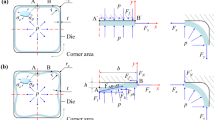Abstract
Tube hydroforming is an attractive manufacturing technology which is now widely used in many industries, especially the automobile industry. The purpose of this study is to develop a method to analyze the effects of the forming parameters on the quality of part formability and determine the optimal combination of the forming parameters for the process. The effects of the forming parameters on the tube hydroforming process are studied by finite element analysis and the Taguchi method. The Taguchi method is applied to design an orthogonal experimental array, and the virtual experiments are analyzed by the use of the finite element method (FEM). The predicted results are then analyzed by the use of the Taguchi method from which the effect of each parameter on the hydroformed tube is given. In this work, a free bulging tube hydroforming process is employed to find the optimal forming parameters combination for the highest bulge ratio and the lowest thinning ratio. A multi-objective optimization approach is proposed by simultaneously maximizing the bulge ratio and minimizing the thinning ratio. The optimization problem is solved by using a goal attainment method. An example is given to illustrate the practicality of this approach and ease of use by the designers and process engineers.
Similar content being viewed by others
References
Carleer B, Kevie G, Winter L, Veldhuizen B (2000) Analysis of the effect of material properties on the hydroforming process of tubes. J Mater Process Technol 104:158–166
Manabe K, Amino M (2002) Effects of process parameters and material properties on deformation process in tube hydroforming. J Mater Process Technol 123:285–291
Boudeau N, Lejeune A, Gelin JC (2002) Influence of material and process parameters on the development of necking and bursting in flange and tube hydroforming. J Mater Process Technol 125–126:849–855
Ko] M, Altan T (2002) Application of two dimensional (2D) FEA for the tube hydroforming process. Int J Mach Tool Manuf 42:1285–1295
Yang J, Jeon B, Oh S (2001) Design sensitivity analysis and Optimization of the hydroforming process. J Mater Process Technol 113:666–672
Park K, Kim Y (1995) The effect of material and process variables on the stamping formability of sheet materials. J Mater Process Technol 51:64–78
Lee SW (2002) Study on the forming parameters of the metal bellows. J Mater Process Technol 130–131:47–53
Ko D, Kim D, Kim B (1999) Application of artificial neural network and Taguchi method to preform design in metal forming considering workability. Int J Mach Tool Manuf 39:771–785
Yang HJ, Hwang PJ, Lee SH (2002) A study on shrinkage compensation of the SLS process by using the Taguchi method. Int J Mach Tool Manu 42:1203-1212
Duan X, Sheppard T (2002) Influence of forming parameters on the final subgrain size during hot rolling of aluminium alloys. J Mater Process Technol 130–131:245–249
Yang WH, Tarng YS (1998) Design optimization of cutting parameters for turning operations based on the Taguchi method. J Mater Process Technol 84:122–129
Huh H, Heo JH, Lee HW (2003) Optimization of a roller levelling process for Al7001T9 pipes with finite element analysis and Taguchi method. Int J Mach Tool Manuf 43:345–350
Anastasiou KS (2002) Optimization of the aluminium die casting process based on the Taguchi method. Proc Inst Mech Eng B, J Eng Manuf 216:969–977
Dhavlikar MN, Kulkarni MS, Mariappan V (2003) Combined Taguchi and dual response method for optimization of a centerless grinding operation. J Mater Process Technol 132:90–94
Kim SJ, Kim KS, Jang H (2003) Optimization of manufacturing parameters for a brake lining using Taguchi method. J Mater Process Technol 136:202–208
Shabeer S, Wang MY (2000) Multi-objective optimization of sequential brakeforming processes. J Mater Process Technol 102:266–276
Marler RT, Arora JS (2003) Review of Multi-Objective Optimization Concepts and Algorithms for Engineering. Technical Report No. ODL-01.03, Optimal Design Laboratory, The University of Iowa, Iowa City
Sauve RG (1999) H3DMAP Version 6 A general three-dimensional linear and nonlinear analysis of structures. Ontario Hydro Technologies Report No. A-NSG-96-120, Revision 1, Toronto
Li B, Metzger DR, Nye TJ (2003) Reliability analysis of the tube hydroforming process based on forming limit diagram. Comput Technol Appl ASME-PVP 458:301–308
Gembicki FW (1974) Vector optimization for control with performance and parameter sensitivity indices. Dissertation, Case Western Reserve University, Cleveland, OH
Author information
Authors and Affiliations
Corresponding author
Rights and permissions
About this article
Cite this article
Li, B., Nye, T. & Metzger, D. Multi-objective optimization of forming parameters for tube hydroforming process based on the Taguchi method. Int J Adv Manuf Technol 28, 23–30 (2006). https://doi.org/10.1007/s00170-004-2338-6
Received:
Accepted:
Published:
Issue Date:
DOI: https://doi.org/10.1007/s00170-004-2338-6



